Are you ready to transform your marketing strategy and skyrocket your conversions? Unleash the power of a sales funnel to guide potential clients from awareness to sale and grow your business.
In the ever-changing realm of marketing, “What Is A Sales Funnel” is more than a question. It’s the gateway to understanding the heart of modern marketing strategies.
For anyone involved in sales and marketing, understanding the concept of a sales funnel is crucial. This vital concept shapes how businesses attract, engage, and convert potential customers. Also, it is an important part of any effective marketing campaign.
Luckily, in this article, we’ll explore the ins and outs of sales funnels, providing you with the knowledge and resources to create your own roadmap to conversions.
Whether you’re an experienced marketer or a novice, the insights shared here will empower you to elevate your marketing game. Also, you transform the potential leads into loyal customers.
Join us on this journey to decode the magic of sales funnels.
Table of Contents
What Is A Sales Funnel And How Does It Work?
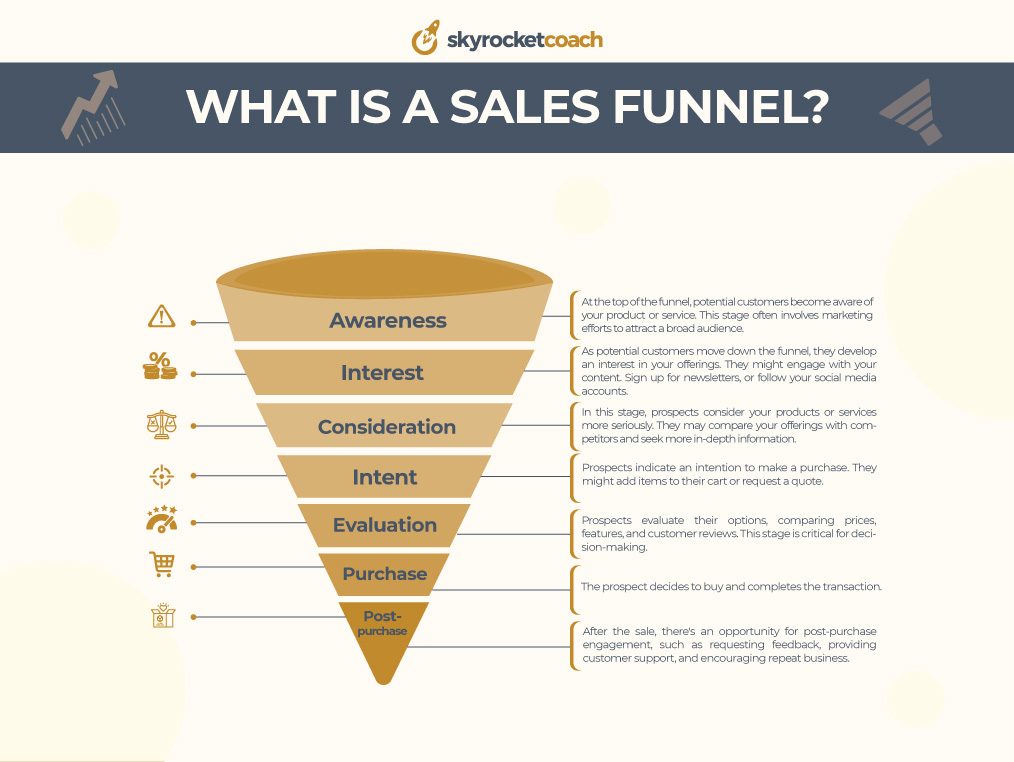
A sales funnel refers to the journey that a potential customer takes from the moment they become aware of your business to the moment they make a purchase decision. It is called a “funnel” because, at each stage of the journey, the number of potential customers decreases as they move closer to making a purchase.
To devise a winning marketing strategy, it is imperative that you gain a deep understanding of the sales funnel and how it operates. The sales funnel is a step-by-step process that prospective customers go through before making a purchase decision. It’s essential to have a clear grasp of this process to improve your conversion rates and drive business growth. Here’s how it works:
- Prospects Move Through the Funnel: Prospects progress from one stage to the next as they become more invested in your product or service.
- Marketing and Sales Efforts in Each Stage: Different marketing and sales efforts are required in each stage to nurture leads effectively. These efforts include content marketing, email marketing, and direct sales interactions.
- Metrics for Measuring Funnel Effectiveness: Key performance indicators (KPIs) such as conversion rate, click-through rate, and customer acquisition cost are used to measure how well the sales funnel is performing.
Sales Funnel Examples
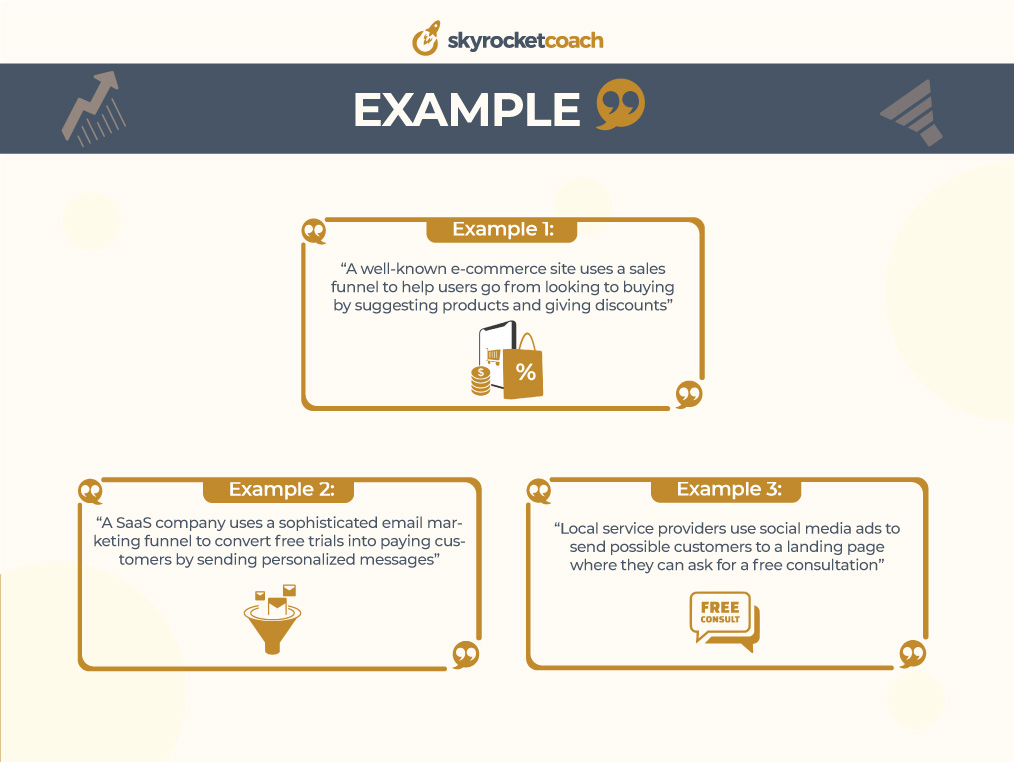
To help explain the ideas, it’s important to show examples of effective sales processes from real life. Here we’ll share some interesting ones:
Example 1: A well-known e-commerce site uses a sales funnel to help users go from looking to buying by suggesting products and giving discounts.
Example 2: A SaaS company uses a sophisticated email marketing funnel to convert free trials into paying customers by sending personalized messages
Example 3: Local service providers use social media ads to send possible customers to a landing page where they can ask for a free consultation.
Note: By looking at these real-life examples, we can learn more about the strategies and tactics that get people to the next step in the sales process.
Sales Funnel Stages
The sales funnel typically consists of several stages, each with a specific purpose. These include:
- Awareness: At the top of the funnel, potential customers become aware of your product or service. This stage often involves marketing efforts to attract a broad audience.
- Interest: As potential customers move down the funnel, they develop an interest in your offerings. They might engage with your content. Sign up for newsletters, or follow your social media accounts.
- Consideration: In this stage, prospects consider your products or services more seriously. They may compare your offerings with competitors and seek more in-depth information.
- Intent: Prospects indicate an intention to make a purchase. They might add items to their cart or request a quote.
- Evaluation: Prospects evaluate their options, comparing prices, features, and customer reviews. This stage is critical for decision-making.
- Purchase: The prospect decides to buy and completes the transaction.
- Post-purchase: After the sale, there’s an opportunity for post-purchase engagement, such as requesting feedback, providing customer support, and encouraging repeat business.
Importance Of Understanding Sales Funnels
Understanding sales funnels allows businesses to optimize their marketing and sales strategies. By identifying the strengths and weaknesses at each stage of the funnel, they can develop targeted campaigns to improve conversion rates and drive revenue.
Additionally, a clear understanding of the sales funnel helps businesses align their marketing efforts with customer needs and preferences. It enables them to create personalized content and offers that resonate with potential customers and guide them towards making a purchase.
What Is A Sales Funnel In Digital Marketing?
In the digital age, the concept of a sales funnel has evolved to suit online marketing strategies. Discuss how sales funnels apply to digital marketing:
- Online Channels: Explain how digital marketing channels like social media, email marketing, and pay-per-click advertising can be integrated into the sales funnel.
- Automation and Personalization: Touch upon the use of marketing automation. Also, you can use personalization to tailor the customer journey in the digital realm.
Sales Funnel Strategy
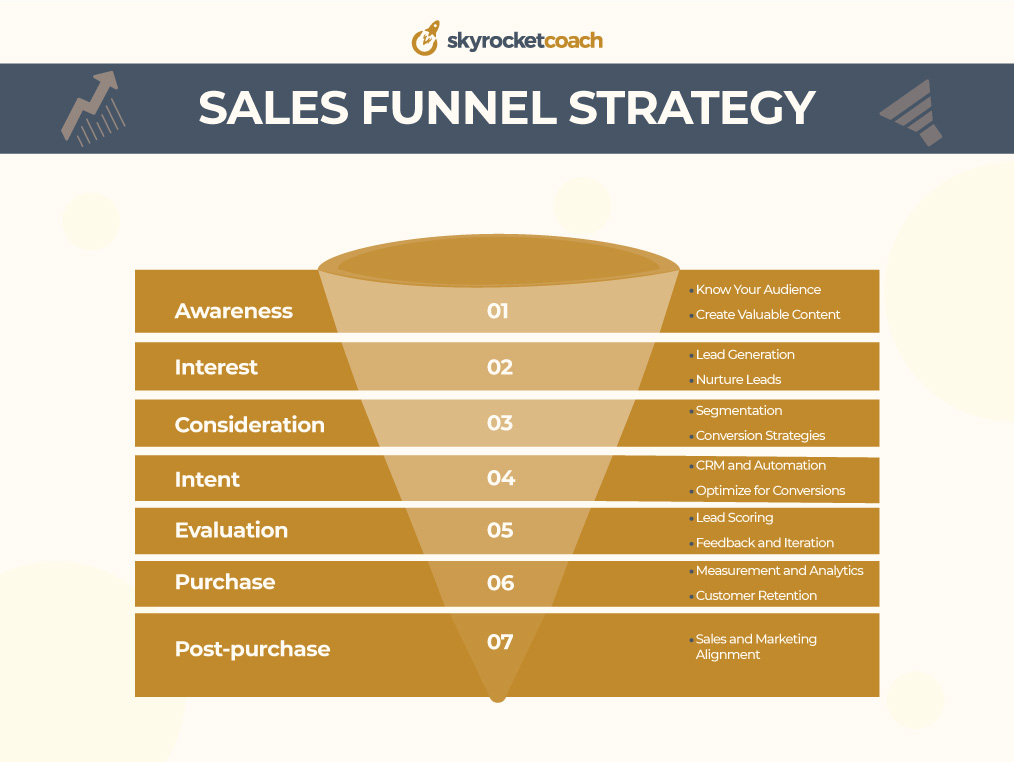
Sales funnel strategy helps you learn how to create a sales funnel for yourself.
You must have a good sales funnel plan to move through the funnel stages and eventually become paying customers. When making your sales flow plan, here are some essential things to keep in mind:
- Know Your Audience: Start by understanding your target audience. Create detailed buyer personas to identify their needs, pain points, and preferences.
- Create Valuable Content: Develop content that addresses the needs of your audience at each funnel stage. Provide informative blog posts, videos, e-books, or webinars that offer value and solve their problems.
- Lead Generation: Use various lead generation techniques to attract potential customers to the top of your funnel. This can include content marketing, social media, SEO, paid advertising, and email marketing.
- Nurture Leads: Once you’ve captured leads, focus on nurturing them. Use email marketing campaigns, personalized messages, and drip campaigns to keep potential customers engaged.
- Segmentation: Segment your leads based on their behavior and interests. Tailor your communication and content to these segments for more effective nurturing.
- Conversion Strategies: Implement strategies to encourage leads to take the next step. This could involve offering free trials, demos, or special promotions.
- Optimize for Conversions: Continuously test and optimize your sales funnel. A/B testing, landing page optimization, and analyzing user behavior can help you improve conversion rates.
- Lead Scoring: Assign scores to leads based on their behavior and engagement. Focus more on leads that are closer to conversion.
- Sales and Marketing Alignment: Ensure that your sales and marketing teams are aligned and communicate effectively. They should work together to nurture and convert leads.
- Measurement and Analytics: Use key performance indicators (KPIs) to track the performance of your sales funnel. Monitor metrics, such as conversion rates, click-through rates, and customer acquisition cost.
- Customer Retention: Don’t forget about post-purchase engagement. Continue providing value to existing customers to encourage repeat business and loyalty.
- CRM and Automation: Consider using customer relationship management (CRM) software and marketing automation tools to streamline your sales funnel processes and track customer interactions.
- Feedback and Iteration: Gather feedback from your customers and use it to iterate and improve your sales funnel strategy. Continuous improvement is key to long-term success.
Implementing A Sales Funnel For Business
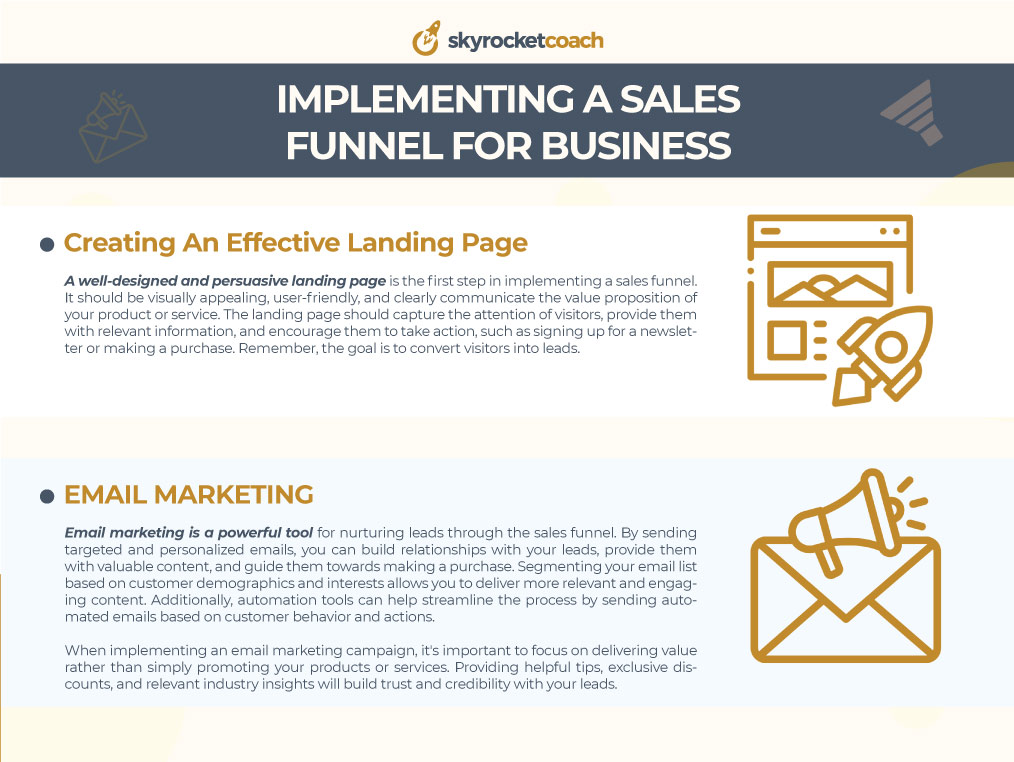
For any business, understanding the concept of a sales funnel is crucial to driving revenue and converting leads into loyal customers.
-
Creating An Effective Landing Page
A well-designed and persuasive landing page is the first step in implementing a sales funnel. It should be visually appealing, user-friendly, and clearly communicate the value proposition of your product or service. The landing page should capture the attention of visitors, provide them with relevant information, and encourage them to take action, such as signing up for a newsletter or making a purchase. Remember, the goal is to convert visitors into leads.
-
Utilizing Email Marketing Campaigns
Email marketing is a powerful tool for nurturing leads through the sales funnel. By sending targeted and personalized emails, you can build relationships with your leads, provide them with valuable content, and guide them towards making a purchase. Segmenting your email list based on customer demographics and interests allows you to deliver more relevant and engaging content. Additionally, automation tools can help streamline the process by sending automated emails based on customer behavior and actions.
When implementing an email marketing campaign, it’s important to focus on delivering value rather than simply promoting your products or services. Providing helpful tips, exclusive discounts, and relevant industry insights will build trust and credibility with your leads.
Tracking And Analyzing Your Sales Funnel
When it comes to running a successful business, understanding your sales funnel is essential. A sales funnel is a visual representation of the journey that a potential customer takes from the initial stages of awareness to making a purchase. By tracking and analyzing your sales funnel, you can identify areas for improvement, optimize conversions, and ultimately increase sales.
Identifying Key Metrics And KPIs

In order to effectively track your sales funnel, it’s important to identify key metrics and key performance indicators (KPIs). It aligns with your business goals. Some common metrics to track include:
- Conversion Rate: This measures the percentage of potential customers. That move from one stage of the sales funnel to the next.
- Average Order Value: This represents the average amount spent by customers on each purchase.
- Customer Acquisition Cost (CAC): This is the average cost of acquiring a new customer.
- Customer Lifetime Value (CLTV): This measures the total value a customer brings to your business over their lifetime.
Note: These indicators may help you evaluate your marketing and sales activities and make data-driven sales funnel improvements.
Optimizing Conversions And Sales
Once you have identified areas for improvement in your sales funnel, you can focus on optimizing conversions and sales. Here are some strategies to consider:
- Streamline the Customer Journey: It’s important to streamline the sales funnel by eliminating unnecessary steps and hurdles for potential buyers.
- Personalize the Experience: Tailor your messaging and offers to individual customers based on their interests, preferences, and buying behavior.
- Implement A/B Testing: Test different variations of your marketing and sales strategies to see which one’s yield the highest conversions.
- Use Retargeting: You should try to get people interested in your goods or services but haven’t bought anything yet to return and finish the buying process.
By continuously tracking, analyzing, and optimizing your sales funnel, you can maximize your chances of converting potential customers into loyal, repeat buyers.
Benefits Of Implementing A Sales Funnel
- Improved Lead Nurturing: A sales funnel allows you to categorize and nurture leads based on their specific stage in the buying journey. By providing targeted content and personalized communication, you can guide them towards a purchase decision.
- Increased Conversion Rates: You can improve your conversion rates by learning about the different steps of the sales funnel and changing your methods to fit each one. It’s more likely that leads will become paid customers if you focus on specific pain spots and offer custom solutions.
- Better Customer Retention: A sales funnel doesn’t just focus on acquiring customers, but also on retaining them. Following up with customers after they’ve bought something, giving them great service, and keeping in touch with them can make them happier and more likely to buy from you again.
Next Steps And Further Resources
If you’re ready to implement a sales funnel in your business, here are a few next steps to consider:
- Evaluate Your Current Sales and Marketing Funnel: Take a closer look at your current sales process and identify any gaps or areas for improvement.
- Design Your Sales Funnel: Determine the stages of your sales funnel and the corresponding actions you need to take at each stage.
- Create Relevant and Valuable Content: Develop content that addresses the needs of your target audience at each stage of the funnel.
- Use Marketing Automation Tools: Implement marketing automation tools to help streamline your sales and marketing processes.
- Continuously Monitor and Optimize: Regularly review your sales funnel performance and make adjustments as needed to improve your conversion rates and overall results.
With the right strategies and tools in place, you can effectively guide potential customers through their buying journey and maximize your business’s growth potential.
Sales Funnel Template
Sales funnel templates provide a structured framework for creating and visualizing your sales funnel. Discuss their benefits and how they can save time and effort:
- Pre-Designed Framework: Explain that sales funnel templates come with predefined stages, making it easier to get started.
- Customization: Mention how templates can be customized to fit the specific needs of your business and target audience.
Final Thoughts
Ultimately, you realize what is a sales funnel. A sales funnel is not just a concept; it’s a powerful tool that defines the success of modern marketing. Understanding the sales funnel is crucial for any business. A sales funnel helps you navigate through the process of turning potential leads into loyal customers.
If you’re unsure about the concept, it’s important to note that with the right strategies, tools, and information, your marketing efforts can yield impressive conversion rates.
To further enhance your sales funnel skills and take your business to new heights, consider working with Skyrocket Coach – a leading expert in funnel services. Together, you can refine your conversion plan to ensure long-term growth and success in the digital age.
FAQs About What Is A Sales Funnel
What is a B2B sales funnel?
A B2B sales funnel is a structured model that represents the journey businesses go through to convert potential business customers, guiding them from initial awareness to the final purchase.
Is a sales funnel a CRM?
No, Customer Relationship Management (CRM) and a sales flow are two different ideas. A sales funnel shows the path a customer takes, and a CRM is software that keeps track of contacts and info about customers.
What is the funnel stage of SEO?
For SEO, the funnel stage refers to where a person is in their journey. It can be early stages of awareness or later stages of research and decision-making before buying a product.

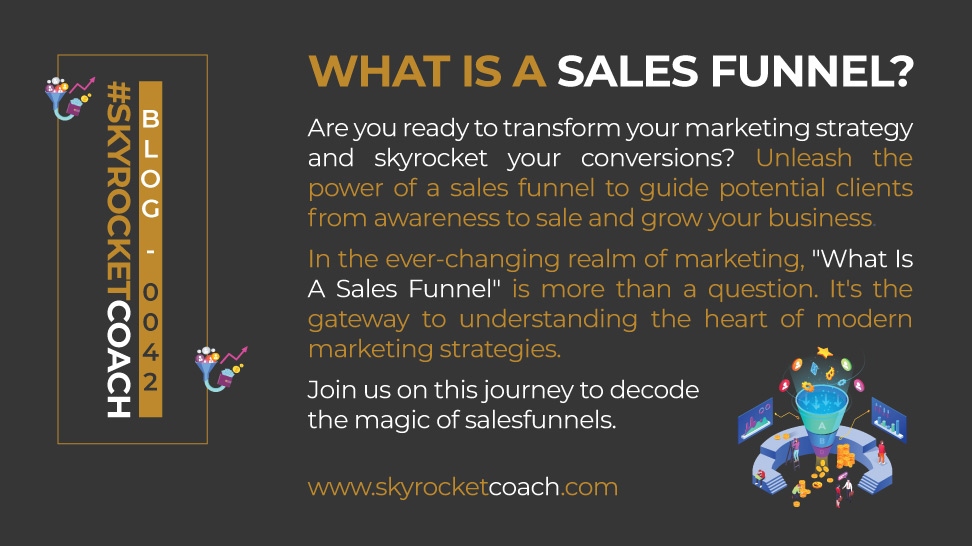
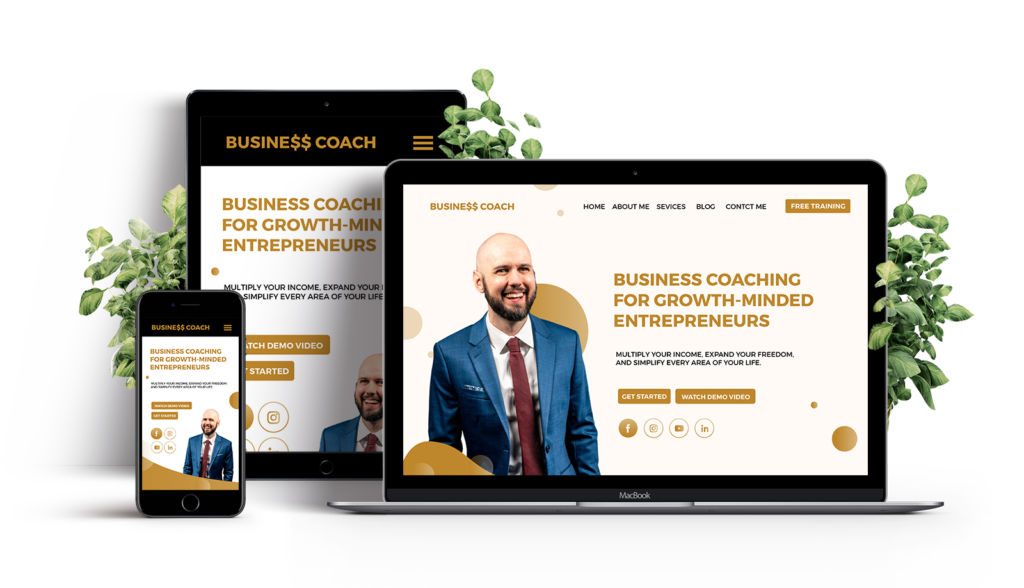
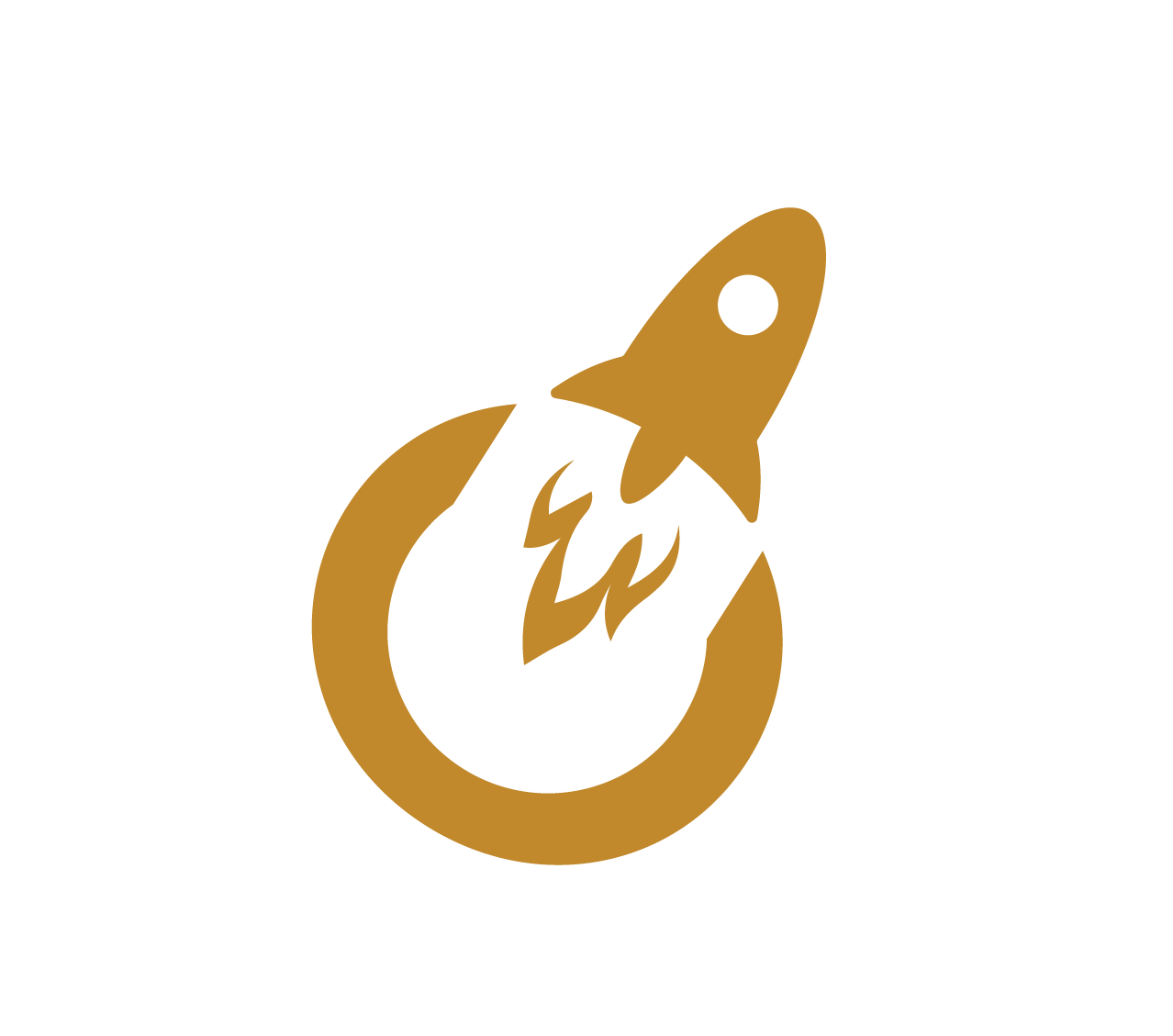
Recent Comments